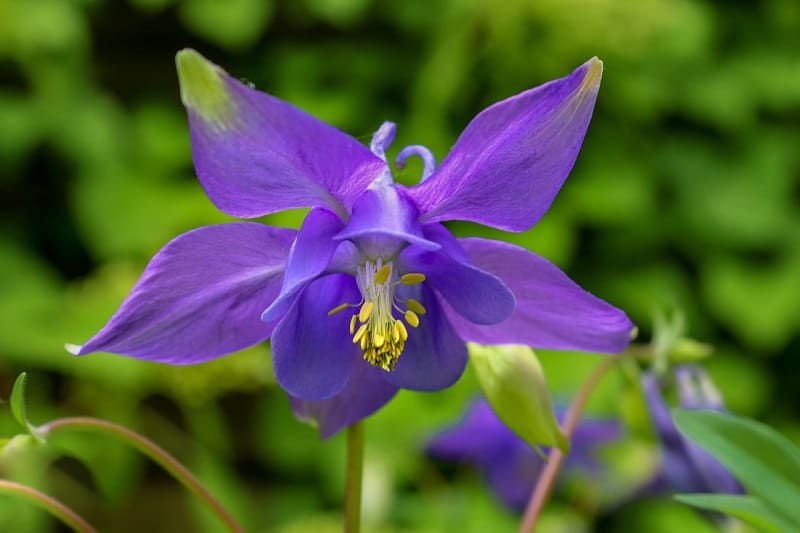The aquilegia flower is a very decorative plant. It produces a large number of blue or white flowers that attract a lot of attention.
Also, it is easy to care for, so much so, that although it is highly recommended to have it in the garden, it can also be kept in a pot.
With minimal attention, you will be able to enjoy it. Yes, almost effortlessly. So considering all this, what are you waiting for, you need to get one.
Origin and characteristics
The aquilegia flower (columbine) plant is very decorative.
Our protagonist is a perennial herbaceous plant native to the temperate zones of Europe and Asia whose scientific name is Aquilegia vulgaris. It is popularly known as columbine. It grows to a maximum height of 1.2 meters, with slender stems. The leaves are dark green, with large basal and petiolate and the rest smaller. The flowers sprout from an erect floral stem that is 3-6cm long, and are blue-violet or white.
Its growth rate is quite fast, and as it blooms every year it is a joy to see it. But it will be even more enjoyable if you make sure to care for it properly.
You may like Anthurium Flower
How to care for the aquilegia flower
Location
The Aquilegia flower (columbine) is a plant that must be outdoors, either in full sun or, better, in an area with partial shade. It only needs a minimum of 4h of direct light per day to be able to produce healthy flowers.
Of course, it should not be put indoors since otherwise we would soon see that it acquires a sad bearing because it is not capable of adapting to the conditions we have at home.
Soil
As it can be both in a pot and in the garden, the soil will be different:
Pot: we can use a universal growing substrate. They also sell at any nursery or garden center.
Garden: grows in fertile soil, with good drainage. In the event that we have a land whose soil is poor in nutrients and/or very compact, we will make a planting hole of about 40 x 40cm and fill it with a universal growing substrate mixed with perlite.
Irrigation
The frequency of irrigation will vary greatly in the year, during the hottest season it will be necessary to water often because the humidity is lost quickly, the rest of the year it will be necessary to space the watering more and more to avoid the roots from rotting.
Also, as each climate is different, the ideal is to check the soil before watering.
Use a digital humidity meter: it is an instrument that, when inserted into the ground, will instantly tell us how wet it is. To be really useful we must introduce it closer to the plant.
Another option is to insert a thin wooden stick: if it comes out with a lot of dirt attached, we will know that it should not be watered.
If the surface of the soil or the substrate immediately loses moisture, check the inner layers dig about 5 or 10 centimeters and if it has the same color that is on the surface (that is, a more or less light brown color), you will water.
Weigh the pot once it has been watered and again after a few days: since the humid soil weighs more than the dry one, this way you will be able to know when to water, guided by this difference in weight.
For general reference water 3 times a week in summer and once or twice a week the rest of the year.
Substrate
From the beginning of spring to the end of summer (it is possible in the fall also if we live in an area with a mild or warm climate) use organic fertilizers, once a month.
In case of having Aquilegia flower in a pot, we must use liquid fertilizers following the instructions specified on the package so that the drainage.
Multiplication
It can be multiplied by seeds in spring.
The first thing to do is fill a 10.5cm diameter pot with universal growing medium.
Afterward, it has to be watered conscientiously.
Then a maximum of 2 seeds are placed on the surface and covered with a thin layer of substrate.
Finally, it is watered again with a sprayer and the pot is placed outdoors, in semi-shade.
If all goes well, they will germinate in 2-3 weeks.
Temperature
Withstands cold and frost down to -5ºC.
What uses does it have?
Apart from being used as an ornamental, since ancient times it has been used as an antipyretic, astringent, depurative, diuretic, diaphoretic and urocolytic.
Likewise, the seeds ground and macerated in olive oil are effective in repelling lice.
But beware: before doing anything you have to consult a specialist, since overdose can lead to death from cardiac or respiratory paralysis.
